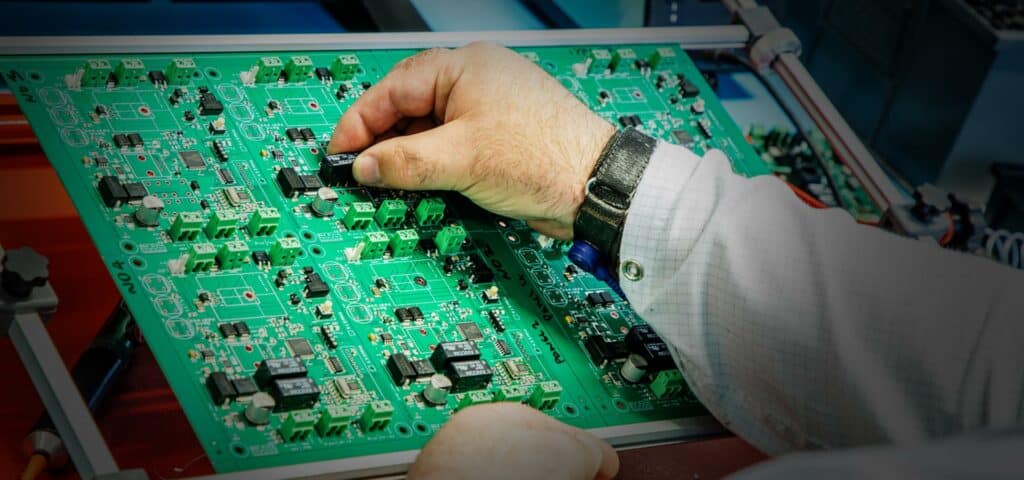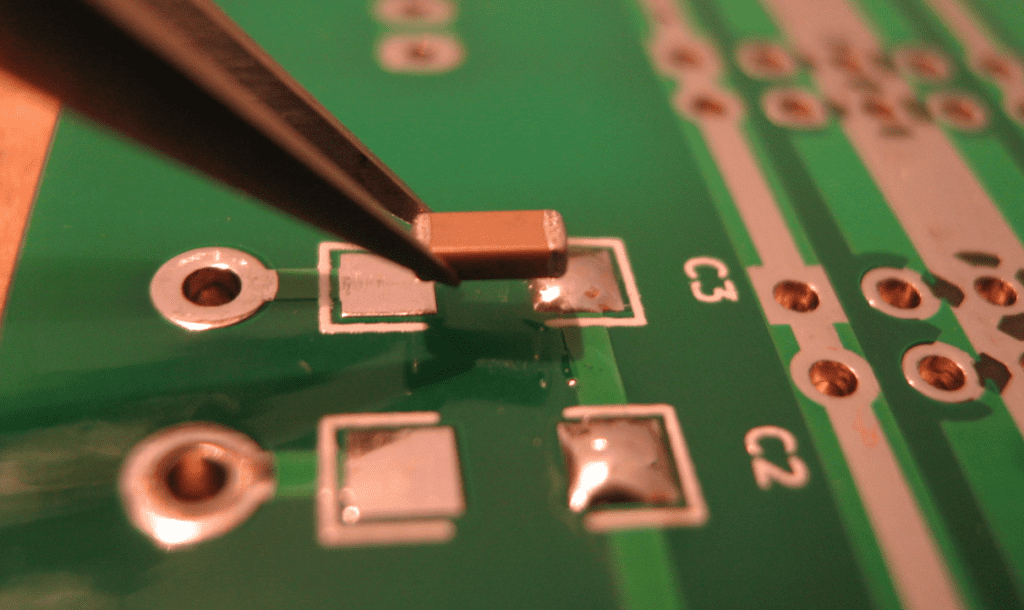Electronic circuit assembly is a crucial part of the manufacturing process for electronic devices. It involves putting together various electronic components such as resistors, capacitors, and transistors to create a functional circuit board. The assembly process can be done manually or through automated machinery, with the latter being more efficient for high-volume production.
The assembly process begins with preparing the circuit board by adding a layer of solder paste onto the surface. The components are then placed onto the board using pick-and-place machines, which accurately position the components onto the solder paste. The board is then heated in a reflow oven, which melts the solder paste and fuses the components onto the board. Once the board has cooled, it is inspected for any defects or errors in the assembly process. Any faulty components are removed and replaced, and the board is retested to ensure it is functioning properly.

Overview
Electronic circuit assembly is the process of putting together electronic components to create a functional circuit. This involves connecting various components such as resistors, capacitors, diodes, transistors, and integrated circuits. The assembly process can be done manually or by using automated equipment.
What is an Electronic Circuit Assembly?
An electronic circuit assembly is a collection of interconnected electronic components that work together to perform a specific function. These circuits can be found in a wide range of electronic devices, including computers, mobile phones, televisions, and medical equipment. Electronic circuit assemblies can be simple or complex, depending on the specific application.
Types of Electronic Circuit Assemblies
There are several types of electronic circuit assemblies, including:
-
Printed Circuit Boards (PCBs): PCBs are the most common type of electronic circuit assembly. They are made by printing a circuit design onto a board using conductive ink or etching a pattern onto a copper-clad board. PCBs are used in a wide range of electronic devices, from simple toys to complex medical equipment.
-
Surface Mount Technology (SMT): SMT is a method of assembling electronic components onto a PCB. It involves placing components directly onto the surface of the board, rather than inserting them through holes. SMT is used in many modern electronic devices due to its small size and high efficiency.
-
Through-Hole Technology (THT): THT is an older method of assembling electronic components onto a PCB. It involves inserting components through holes in the board and soldering them to the other side. THT is still used in some applications, such as high-power circuits.
In conclusion, electronic circuit assembly is a critical process in the production of electronic devices. Understanding the different types of assemblies and their applications is essential for anyone working in the electronics industry.
Components

Resistors
Resistors are passive electronic components that limit the flow of current in a circuit. They are commonly used to set the gain of amplifiers, bias transistors, and control the brightness of LEDs. Resistors come in a variety of shapes and sizes, from small surface mount packages to large wire-wound resistors. They are rated by their resistance value in ohms and their power rating in watts.
Capacitors
Capacitors are passive electronic components that store electrical energy in an electric field. They are commonly used to filter noise, smooth power supplies, and block DC signals while allowing AC signals to pass. Capacitors come in a variety of shapes and sizes, from small surface mount packages to large electrolytic capacitors. They are rated by their capacitance value in farads and their voltage rating in volts.
Integrated Circuits
Integrated circuits (ICs) are complex electronic components that contain many transistors, resistors, and capacitors on a single chip. They are commonly used to perform specific functions, such as amplifiers, oscillators, and microcontrollers. ICs come in a variety of packages, including DIP, SOIC, and QFN. They are rated by their function, pin count, and voltage rating.
Diodes
Diodes are electronic components that allow current to flow in one direction while blocking current in the opposite direction. They are commonly used to rectify AC signals, protect circuits from voltage spikes, and generate light in LEDs. Diodes come in a variety of shapes and sizes, from small surface mount packages to large power diodes. They are rated by their voltage drop in volts and their current rating in amperes.
Transistors
Transistors are electronic components that amplify or switch electronic signals. They are commonly used to amplify audio signals, switch power supplies, and control motors. Transistors come in a variety of shapes and sizes, from small surface mount packages to large power transistors. They are rated by their gain, voltage rating, and current rating.
That’s it for the Components section.
Assembly Process
Designing the Circuit Board
Before assembling the electronic circuit, it is essential to design the circuit board. The circuit board design should be based on the schematic diagram of the circuit. The design should consider the size, shape, and number of components that will be mounted on the board. There are various software tools available to design circuit boards, such as Eagle, Altium, and KiCad. These tools help to create a layout of the board and generate the Gerber files needed for manufacturing.
Soldering Components
Once the circuit board design is complete, the next step is to assemble the components on the board. The components are mounted on the board using soldering techniques. There are two primary methods of soldering: through-hole and surface mount. Through-hole components require holes to be drilled on the board, while surface mount components are mounted directly on the board. The soldering process involves applying heat to the solder and melting it to create a bond between the component and the board. It is essential to ensure that the components are placed correctly and the solder joints are of high quality to avoid any issues with the circuit’s functionality.
Testing the Circuit Board
After soldering the components, the circuit board needs to be tested to ensure that it is functioning correctly. The testing process involves checking for any short circuits, open circuits, or incorrect connections. Various testing methods can be used, such as visual inspection, continuity testing, and functional testing. Visual inspection involves checking for any visible defects, such as solder bridges or missing components. Continuity testing is used to check for any open circuits, while functional testing is used to check if the circuit is operating as intended.
In conclusion, the assembly process of electronic circuits involves designing the circuit board, soldering components, and testing the circuit board. The process requires attention to detail and precision to ensure that the circuit functions correctly. By following these steps, you can create a high-quality electronic circuit that meets your requirements.
Quality Control
Quality control is an essential part of electronic circuit assembly. It ensures that the final product meets the required specifications, is free from defects, and functions as intended. Quality control involves a series of checks and tests that are performed at various stages of the assembly process.
One of the first quality control checks is the inspection of the components that will be used in the circuit. The components must meet the required specifications, and any defects or inconsistencies must be detected and addressed before they are used in the assembly. This is often done by visual inspection, testing, and verification of the components’ datasheets.
During the assembly process, quality control checks are performed to ensure that the components are correctly placed and soldered. These checks include visual inspection, automated optical inspection (AOI), and X-ray inspection. AOI uses cameras to inspect the solder joints and components for defects, while X-ray inspection is used to verify the integrity of the solder joints and detect any hidden defects.
After the circuit is assembled, it undergoes functional testing to ensure that it performs as intended. This testing involves applying power to the circuit and verifying that it meets the required specifications. The circuit may also undergo environmental testing, such as temperature and humidity testing, to ensure that it can operate under various conditions.
In conclusion, quality control is an essential part of electronic circuit assembly. It ensures that the final product meets the required specifications, is free from defects, and functions as intended. By performing quality control checks at various stages of the assembly process, manufacturers can ensure that their products are of high quality and meet the expectations of their customers.
Common Issues

Electronic circuit assembly can be a complex process, and even the smallest mistake can cause significant issues. Here are some common issues that can arise during electronic circuit assembly:
Soldering Issues
Soldering is an essential part of electronic circuit assembly, and it can be a source of many problems. Some common soldering issues include:
- Cold joints: These are joints where the solder has not melted completely, resulting in a weak connection.
- Solder bridges: These occur when the solder connects two adjacent pins, causing a short circuit.
- Solder balls: These are small balls of solder that can form on the surface of the circuit board, causing shorts and other issues.
Component Issues
Components are the building blocks of electronic circuits, and they can also be a source of problems. Some common component issues include:
- Incorrect component placement: This can cause the circuit to fail to work correctly or not work at all.
- Incorrect component values: This can cause the circuit to work incorrectly or not work at all.
- Damaged components: This can cause the circuit to fail to work correctly or not work at all.
Design Issues
The design of the circuit can also be a source of problems. Some common design issues include:
- Incorrect trace routing: This can cause the circuit to fail to work correctly or not work at all.
- Insufficient clearance: This can cause shorts and other issues.
- Grounding issues: These can cause noise and other problems.
In conclusion, electronic circuit assembly is a complex process, and many issues can arise during the assembly process. By being aware of these common issues, you can take steps to avoid them and ensure that your circuit works correctly.

